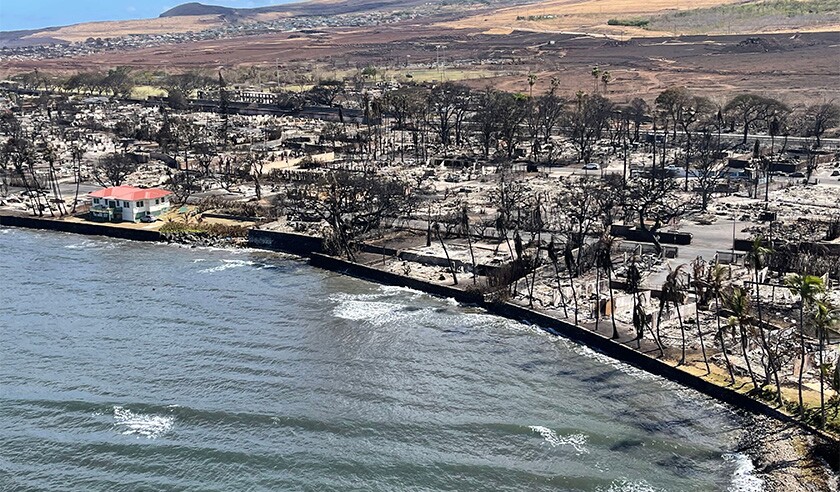Early estimates from modeling firms suggest a range from $1bn to a little above $3bn, with a majority of the damaged structures being residential.
Sources added that a big chunk of losses will likely come from middle market homes written in the admitted market, with values surpassing the $100,000 mark.
Part of the damage may come from high-net-worth properties, but Lahaina alone does not have a high concentration of these multi-billion-dollar homes compared to Kapalua or the island of Lanai.
The largest loss estimate so far comes from Karen Clark & Company (KCC) at roughly $3.2bn for insured property losses. This followed commentary earlier this week that the event would likely be the second largest in Hawaii’s history after Hurricane Iniki, which incurred $3.3bn in insured losses.
However, KCC’s $3.2bn estimate does not include boat, marina and inland marine losses, as well as contingent BI losses that could occur from Maui properties that were not directly impacted by the fires, according to the company.

Commercial property sources have said the damages seem relatively small, but the industry is keeping a close eye on the development of contingent BI claims.
Sources said the wildfire did not touch the strip of high-end hotels that includes Sheraton, The Westin, Marriott and Hyatt establishments. During the weekend, Hawaiian officials urged tourists to avoid traveling to Maui, but welcomed back tourists to the region on Wednesday except the west side, where restorations are ongoing, according to media reports.
Steve Bowen, Gallagher Re’s chief science officer, said: “There's going to be a period of prolonged time in terms of how much [business interruption] is actually going to occur.”
“Given all of these things, it's going to take at least six months, if not more than a year, for us to feel like we have a settled number that we can be comfortable with.”
Demand surge
The construction period and cost of rebuilding can be boosted by the geographical distinctiveness of Hawaii as an island.
KCC senior atmospheric scientist Dan Ward told this publication that demand surge can be a factor for islands with limited resources, whereby material and labor demand outstrip available supply, resulting in increased costs.
“During Hurricane Iniki in 1992, construction costs increased above normal levels in Hawaii, with a four- to six-week delay for the additional supply of building materials to arrive in some impacted locations a primary cause,” he said.
At the moment, KCC estimates the demand surge in Maui will be less than what was observed during Iniki and in the “single-digit range”, as the insured losses for the fire are materially less than Hurricane Iniki based on current values.

Bowen also pointed out the timing of the event as the industry nears peak hurricane season. If a major hurricane makes landfall in the US while Maui is rebuilding, there is risk that outside events will have a direct impact on the island's recovery.
In 2017, for example, California wildfires broke out in tandem with hurricanes Harvey, Irma and Maria. The recoveries altogether resulted in increased costs for construction supplies and a shortage of workers and adjusters.
In Maui, several properties, especially those on Front Street, were old historic buildings whose insured values had not been updated for years and may be subject to more stringent building codes for reconstruction – both of which will cause delays in the claims and payment process.
Joe Marsh, senior vice president at Alliant, added that many buildings were mainly insured by local companies based in the Islands.
“The direct hit is going to be felt here with the local companies that are in Hawaii, more so than a Lloyd's syndicate that may have been insuring something that was high risk or hard to place,” he said.
Moody’s has listed First Insurance, Island Insurance, RLI and Hawaiian Insurance as carriers that have 100% concentration in homeowners' in Hawaii. DB Insurance derives 56% of its premium from the state.
Rate increases
In line with the broader trend, Hawaii’s property insurance market had been tightening before the wildfires occurred, where certain areas were seeing carriers implement 5%-10% rate increases this year.
“With what just happened, you can 100% expect the property market to harden up, with carriers super selective on what they do, because the size of this is going to hit not just carriers, but it’s obviously going to affect their reinsurance,” Marsh said.
By volume of direct premiums written, State Farm, Allstate, USAA and Liberty Mutual also made it on Moody’s top list of homeowners’ insurers on the Islands. However, the rating agency expected the large carriers to “readily absorb” the losses, given Hawaii is a small fraction of their overall portfolio.
Based on property loss estimates so far, sources view the Lahaina Fire as more of an earnings event and one that underscores the concern on aggregates caused from secondary perils. The wildfire will be another loss event this year, on top of an unusually active H1 2023 of US convective storms.
Cause of fire
Another development to watch is the cause of the wildfire and the potential impact on casualty lines. The investigation is ongoing, but Lahaina residents have already filed a lawsuit against Hawaiian Electric, claiming the utility company’s power lines were the possible cause of the deadly fires.
Similar lawsuits were filed against Pacific Gas and Electric (PG&E) and its former executives after the 2018 Camp Fire in California. In the aftermath, the company reached settlements with victim groups valued at approximately $25.5bn.
The PG&E payouts had the effect of allowing some residential insurers to reduce their losses from the Camp Fire, as the liabilities transferred to the utility firm.
Media reports state that Hawaiian Electric is already speaking with restructuring advisory firms, discussing options to address the financial and legal challenges regarding its potential liabilities.



